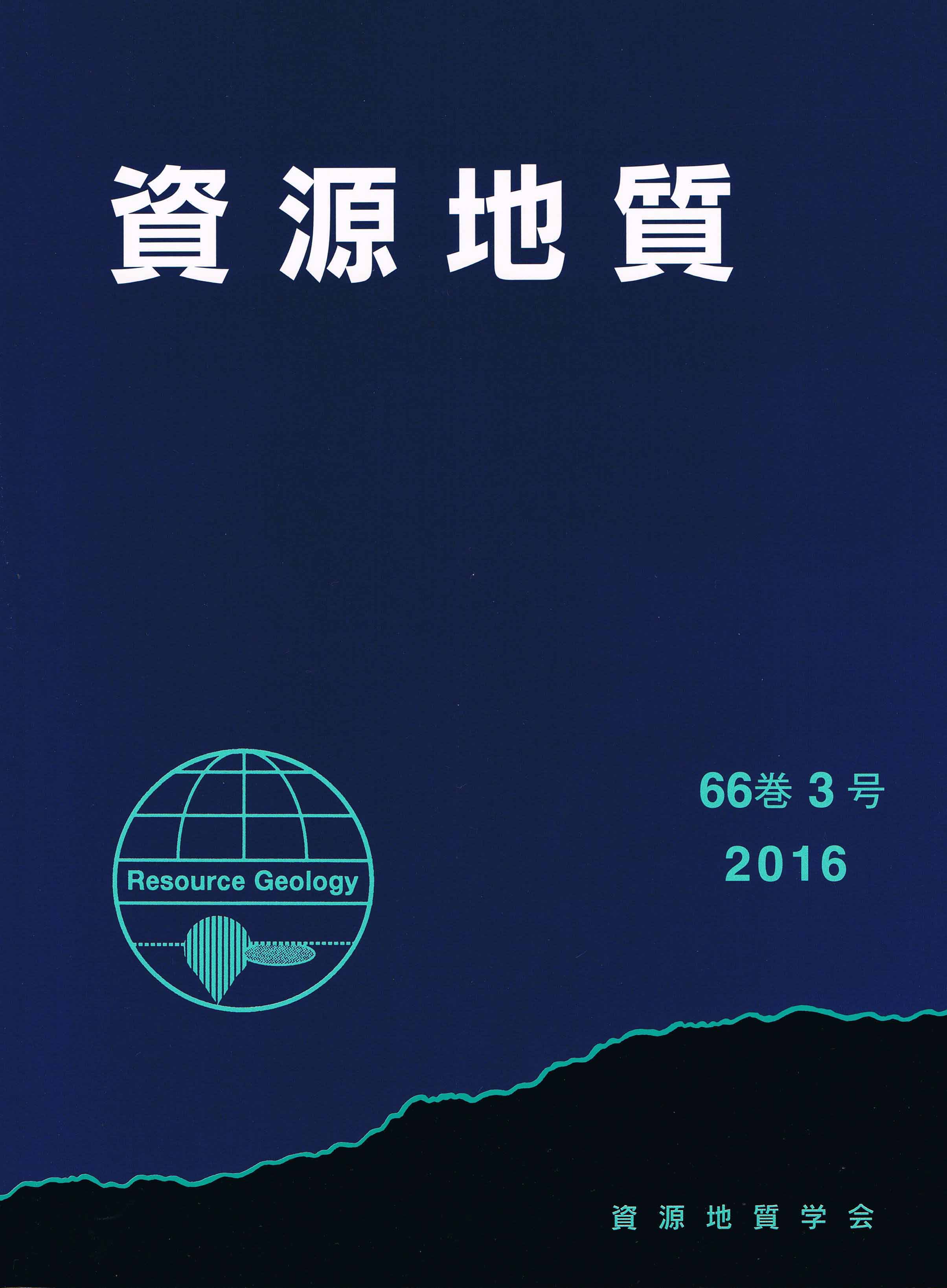
- Issue 2 Pages 79-
- Issue 1 Pages 1-
- |<
- <
- 1
- >
- >|
-
Keiko KOSHIDA, Ryohei NAKAI, Ryuya SATO, Yo KITAMURA, Shinichi TAKAKUR ...Article type: Articles for Annual Meeting for Prospecting of Ore Deposits
2022Volume 72Issue 1 Pages 1-12
Published: May 27, 2022
Released on J-STAGE: November 13, 2022
JOURNAL FREE ACCESSSilicified ore, used for flux at the copper smelters in Japan, often contains gold(Au). Today, only a few mines in Japan produce and sell Au-bearing silicified ore to copper smelters, and their importance are becoming increasing. The Iwado mine, one of the few mines, is the high-sulfidation type deposit located in the Nansatsu district, southwestern Kagoshima prefecture. Although it is known that the silicified rocks occurred in the Iwado-yama area at the western end of the Iwado mine, its potential(volume and Au grade) has not been evaluated quantitively due to lack of exploration data both in quality and in quantity. JX Nippon Mining & Metals Corp. carried out geological, geochemical and electrical resistivity surveys for revealing the silicified ore extent in the Iwado-yama area. The results showed that the ore body is distributed in a northeast-southwest direction along the Iwado-yama mountain ridge and thinner toward the southwest. Geochemical survey showed the silicified rocks in this area could serve as flux for smelters, and in terms of Au the historical drilling information encourages further exploration activities. In order to outline the ore body and to estimate Au content, further drilling surveys should be conducted, and hopefully result in additional ore reserves for the Iwado mine.
View full abstractDownload PDF (4210K)
-
Tatsuo NOZAKI, Keiko SATO, Hidenori KUMAGAI, Kazuhiko SHIMADA, Jun-ich ...2022Volume 72Issue 1 Pages 13-20
Published: May 27, 2022
Released on J-STAGE: November 13, 2022
JOURNAL FREE ACCESSWe determined the K-Ar ages of phengite occurring as a gangue silicate mineral in the massive sulfide ores from the Kotsu and Iyo Besshi-type volcanogenic massive sulfide (VMS) deposits in the Sanbagawa high-P/T metamorphic belt, southwest Japan. The K-Ar ages of phengite are dated to be ca. 45 or 85 Ma and these ages correspond to the timing of initial or terminal stages of regional retrograde metamorphism. Contrastingly, the Re-Os isochron ages of sulfide mineral aggregates from the Kotsu and Iyo Besshi-type VMS deposits are ca. 145 Ma, which is much older than those of phengite K-Ar ages. Since exactly the same ore samples were used for both K-Ar and Re-Os geochronology, it was confirmed that the K-Ar isotope system was reset due to the regional metamorphism up to lower epidote-amphibolite facies, although the Re-Os isotope system retained the original geochemical and isotopic composition even though the regional (Sanbagawa high-P/T) metamorphism.
View full abstractDownload PDF (1792K) -
Ken NAKAYAMA, Kentaro NAKAMURA, Koichiro FUJINAGA, Yutaro TAKAYA, Sat ...Article type: research-article
2022Volume 72Issue 1 Pages 21-55
Published: May 27, 2022
Released on J-STAGE: November 13, 2022
JOURNAL FREE ACCESSThe Shimokawa cupriferous iron sulfide deposit located in the Cretaceous to Paleogene Hidaka Belt produced 6.8 Mt of crude ore, with an average grade of 2.3% Cu and 1% Zn, until it’s closure in 1983. The sulfide deposit occurs in the Shimokawa greenstone, comprises dolerite sills and conformably intercalated argillites, and is preferentially hosted within argillites. The major ore minerals of the deposit are pyrite, chalcopyrite, pyrrhotite, and sphalerite, which form platy and/or lenticular bodies with low aspect ratios. The mineralization stages in the argillites can be divided into early and late stages. The early-stage mineralization is characterized by pyrite ores consisting of previous framboidal pyrites and scab-like fine pyrite aggregates, subsequent overgrown pyrites such as colloform pyrites, euhedral pyrites on the fringe of previously formed fine pyrites, and euhedral pyrites in carbonate and argillite substrates. This kind of low-temperature mineralization likely took place in a mixing zone of thermogenic hydrocarbon and carbon dioxide degraded from organic matter, low-temperature hydrothermal fluids, and unconsolidated sediments on or beneath the seafloor. The late-stage mineralization process forms a banded and stockwork ore primarily hosted by argillites; it is characterized by high-temperature mineral assemblages such as chalcopyrite-pyrrhotite-sphalerite with a minor amount of cubanite, mackinawite pentlandite, magnetite, and electrum. With hydraulic fracturing, the late-stage hydrothermal fluids diffuse laterally in unconsolidated sediments and are superimposed on the early-stage ore as a sub-seafloor replacement deposit. Earlier dolerite sills and early-stage sulfide ores act as cap rocks to control lateral fluid diffusion. Argillites show the chemical composition of the matured continental island arc in the Th-Sc-Zr diagram and the local anoxic to suboxic environment indicated by proxies of redox-sensitive elements. The occurrence of pillowed dolerite sills with quenched glassy selvages and micro-scale peperites suggests that dolerite sills were emplaced into unconsolidated sediments. Some dolerite sills penetrate massive sulfides; however, on rare occasions, sulfides disseminate in dolerite sills. Overall, basic magma activity, sedimentation of fine-grained terrigenous clastic sediments, and sulfide mineralization might have occurred simultaneously. Dolerite sills mainly comprise “N-type” dolerite with characteristics of N-MORB-like (normal-type mid-oceanic ridge basalt) to C-MORB-like (contaminated-type mid-oceanic ridge basalt) geochemistry, as indicated by a crustal contamination vector in the Th/Yb-Nb/Y diagram; they also include small quantities of “E-type” dolerite with an enriched character. The Pb isotope characteristics indicate that Pb of sulfide ore originated from both dolerite and argillite. Unlike the Besshi-type sulfide deposits in the Sanbagawa metamorphic belt that formed at the sediment-free mid-oceanic ridge and suffered eclogite facies metamorphism at the deeper subduction zone level, the Shimokawa deposit associated with dolerite sills and argillites might have been formed in the sedimented spreading center of the Izanagi–Pacific plate located in the paleo-Hidaka sea between paleo-northeast Japan and the paleo-Kuril arc.
View full abstractDownload PDF (5092K)
- |<
- <
- 1
- >
- >|